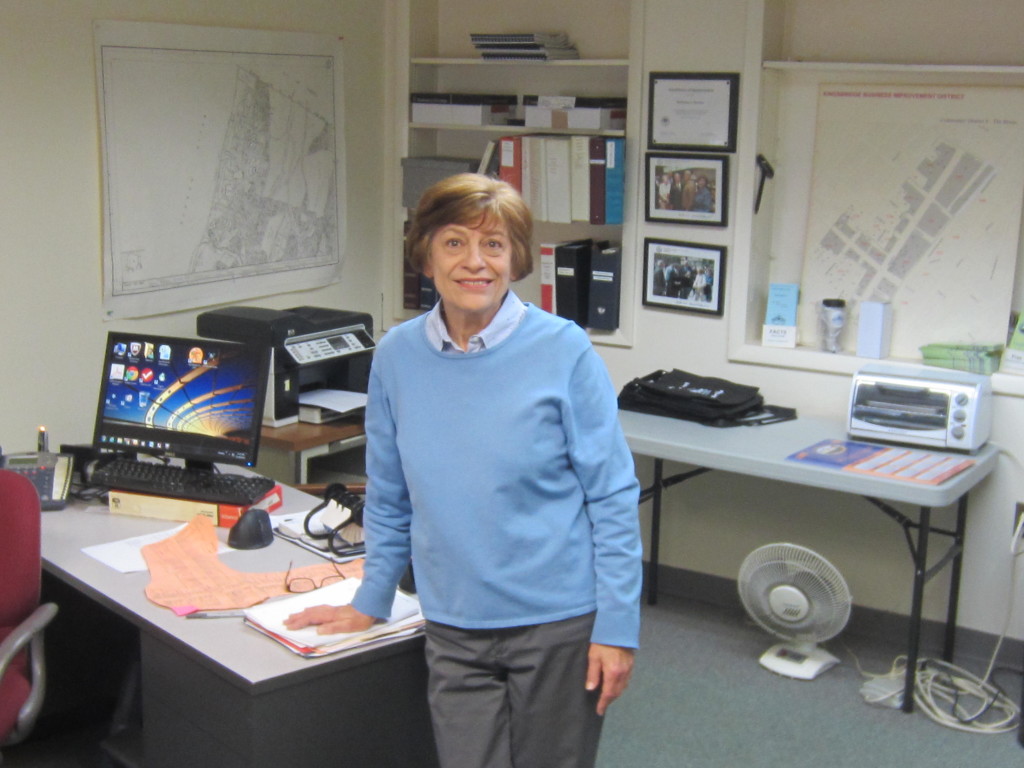
Photo by David Cruz
By DAVID CRUZ
At an upstairs office just below a mechanic shop on Broadway, Katherine Broihier looks ahead. The yearly calendar out of the way, Broihier’s focus turns to a light fixture project for Broadway. The project, one of many for 2015, will likely be accomplished by her and her alone.
So has been the case for Broihier, serving as the executive director, and surprisingly its lone employee, of the Kingsbridge BID. The commercial district abuts the Major Deegan Expressway, spread underneath the number 1 elevated subway train, earning the phrase, “It’s All Under the Bridge.”
Until recently, the once sleepy BID is now experiencing a jolt of energy, creating a type of renaissance not seen since the BID was first signed into law in mid-2001.
In the space of 13 years, the Kingsbridge BID has shifted from a dormant business corridor to one where retail space has maxed out. The L-shaped BID runs from Broadway between West 230th and West 236th streets and West 231st Street between Corlear Avenue and the Bailey Avenue entrance to the Major Deegan Expressway, occupying nearly 200 services. There, shoppers can find longtime mainstays peppered with newly opened establishments.
Some of those familiar businesses include Williams Funeral Home (its owner helms as BID chairman), Robert E. Hill Real Estate (Gary Moore was its first chairman) and Aaron Plum Insurance, which have all done business in the BID for at least 50 years.
Those establishments line up alongside the new Broadway Plaza strip mall, the BID’s newest amenity. Location appears entrenched in its marketing. Many use the word Broadway as a default phrase when titling their stores.
These days, demand for space within the BID is high, according to Broihier. The property that once occupied Loehmann’s clothing store, a neighborhood staple since 1920 until its closure last year, will now house a self-storage facility. Meantime, a seven-story building will replace the recently closed Stack’s Tavern, a veteran Irish bar.
In many instances, inquiring property owners are often disappointed to learn an empty storefront is indeed taken. “There’re no vacancies,” said Broihier. “I know other BIDs that they create on their website, ‘we have vacancies, call this number. Call us.’ I don’t bother.”
A portion of the BID’s success is due to economic activity happening in its outskirts. At 225th Street and Broadway, just grazing the BID, thousands of shoppers frequent the Target mall, which opened 10 years ago.
“When the Target development started, other developers started looking at us because that’s one of the most successful Targets around,” said Broihier. “Don’t even think about going there on the weekends. It’s insane.”
And as buzz for Target grew, business in the BID still laid dormant. Still, it proved advantageous for Broihier. In her first years, she focused on beautifying the area, as most BID missions go.
“When I first came here, the first thing from the board was clean up the streets,” said Broihier, remembering when her list of graffiti hotspots was a page and a half long. Graffiti removal crews routinely, and stubbornly, erased tags from the neighborhood, realizing taggers often move on if their work is gone. The tactic has proven useful for Broihier, whose page and a half list has shrunk. “Now I’m lucky if I have 10 spots or less.”
The free time has also allowed Broihier to compile data on the business corridor. Obsessed with tracking property values, Broihier regularly does the math on the price of property, where a portion of it goes towards the BID’s yearly budget. She’s estimated that rates have risen to 43 percent in the last decade. The figure could be seen as a testament to the attractiveness of the BID.
“There’s enough commercial area here, it’s a safe area, it looks presentable and developers have just inundated the area,” said Broihier. “There’s a lot of changes going on.”




